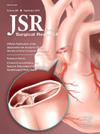Benchmarking Ensemble Models to Predict Prolonged Hospital Stay in Traumatic Brain Injury: A Single-Institution Study
IF 1.7
3区 医学
Q2 SURGERY
引用次数: 0
Abstract
Introduction
Prolonged length of stay (PLOS) in hospitals is a critical metric representing quality and efficiency of care, especially for patients with traumatic brain injury (TBI). Machine learning offers the potential to predict PLOS, although class imbalance, limited sample size, or lack of generalizability impact their real-world application. This study benchmarks machine learning models from prior studies and explores ensemble models to predict PLOS in TBI patients and address domain adaptation concerns in surgical settings.
Methods
An anonymized dataset of 263 adult TBI patients admitted to a single level 1 trauma intensive care unit was used. Nine features were used across basic demographic, clinical, and procedure status variables. Extreme Gradient Boosting (XGBoost), Support Vector Machine (SVM), and Artificial Neural Network (ANN) machine learning algorithms were used, with hyperparameters optimized using GridSearchCV. The SA2DELA framework was used to build ensemble models. Performance metrics were analyzed holistically using a critical difference diagram and post hoc analyses.
Results
The ensemble models combining XGBoost, ANN, and SVM, as well as XGBoost with a snapshot ANN, outperformed the base models (are under the curve: 0.87, critical difference rank: 2.3, Conover post hoc P < 0.05). Bias–variance–diversity decomposition highlighted the complementary strengths of XGBoost and ANN, whereas SVM added incremental improvements. Feature importance identified age, body mass index, and injury severity score as predictors of PLOS.
Conclusions
This study is the first to benchmark established machine learning models and implement ensemble techniques for predicting PLOS in TBI patients. Combining complementary algorithms in a standardized framework can improve robustness in data-constrained and diverse settings. Future studies should incorporate multiclass or regression models and use stronger domain adaptation analyses.
预测外伤性脑损伤延长住院时间的基准集成模型:一项单机构研究
住院时间延长(PLOS)是代表护理质量和效率的关键指标,特别是对于创伤性脑损伤(TBI)患者。机器学习提供了预测PLOS的潜力,尽管类不平衡、有限的样本量或缺乏通用性会影响它们在现实世界中的应用。本研究对先前研究中的机器学习模型进行了基准测试,并探索了集成模型来预测TBI患者的PLOS,并解决手术环境中的领域适应问题。方法采用匿名数据集,收集了263名在同一家1级创伤重症监护病房住院的成人TBI患者。9个特征被用于基本的人口统计学、临床和手术状态变量。使用极端梯度增强(XGBoost)、支持向量机(SVM)和人工神经网络(ANN)机器学习算法,并使用GridSearchCV对超参数进行优化。SA2DELA框架用于构建集成模型。使用关键差异图和事后分析对性能指标进行全面分析。结果结合XGBoost、人工神经网络和支持向量机的集成模型,以及XGBoost与快照人工神经网络的集成模型,均优于基本模型(曲线下值:0.87,临界差秩:2.3,Conover post hoc P <;0.05)。偏差-方差-多样性分解突出了XGBoost和人工神经网络的互补优势,而支持向量机则增加了增量改进。特征重要性确定年龄、体重指数和损伤严重程度评分为PLOS的预测因子。该研究首次对已建立的机器学习模型进行了基准测试,并实现了用于预测脑外伤患者PLOS的集成技术。在标准化框架中结合互补算法可以提高数据约束和不同设置中的鲁棒性。未来的研究应结合多类或回归模型,并使用更强的领域适应分析。
本文章由计算机程序翻译,如有差异,请以英文原文为准。
求助全文
约1分钟内获得全文
求助全文
来源期刊
CiteScore
3.90
自引率
4.50%
发文量
627
审稿时长
138 days
期刊介绍:
The Journal of Surgical Research: Clinical and Laboratory Investigation publishes original articles concerned with clinical and laboratory investigations relevant to surgical practice and teaching. The journal emphasizes reports of clinical investigations or fundamental research bearing directly on surgical management that will be of general interest to a broad range of surgeons and surgical researchers. The articles presented need not have been the products of surgeons or of surgical laboratories.
The Journal of Surgical Research also features review articles and special articles relating to educational, research, or social issues of interest to the academic surgical community.

 求助内容:
求助内容: 应助结果提醒方式:
应助结果提醒方式:


